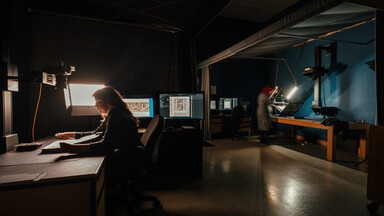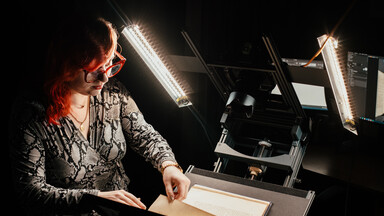Digitiú

Oidhreacht na hÉireann a Thrasfhoirmiú don Ré Dhigiteach
Ó lámhscríbhinní uathúla go grianghraif stairiúla, táimid ag obair chun níos mó dár mbailiúcháin a thabhairt ar líne. Leis sin, déantar iad níos éasca a fheiceáil, staidéar a dhéanamh orthu agus sult a bhaint astu, cibé áit a bhfuil tú ar an domhan.
Digitiú
Is ionann digitiú agus an próiseas ina n-athraítear ábhair fhisiceacha — amhail grianghraif, litreacha, leabhair, nuachtáin, taifeadtaí agus nithe fisiceacha — go foirmeacha digiteacha. Le digitiú, cabhraítear dúinn ag Leabharlann Náisiúnta na hÉireann bunsaothair leochaileacha a chosaint agus ag an am céanna oidhreacht chultúrtha na hÉireann a dhéanamh níos insroichte do dhaoine ar fud an domhain.
An Fáth a nDéanaimid Ábhair a Dhigitiú
- Chun ábhair bhunaidh a chosaint ar dhamáiste arb é láimhseáil nó aois is cúis leis
- Chun rochtain níos leithne a chur ar fáil, go háirithe dóibh siúd nach bhfuil in ann cuairt a thabhairt ar an leabharlann iad féin
- Chun tacú le taighde, foghlaim agus fiosrú le cóipeanna digiteacha ardchaighdeáin atá inchuardaithe

Obair sa Chúlra
Tá níos mó i gceist le digitiú ná scanadh. Tá saineolas agus comhordú idir foirne agus ranna NLI i gceist leis, lena n-áirítear:
- Ábhair a roghnú agus a chur in ord tosaíochta le haghaidh digitithe
- Meiteashonraí a chruthú ionas go bhféadtar gan mír a aimsiú, a thuiscint agus a lua, agus ionas go bhfuil cearta agus cead athúsáide soiléir d’úsáideoirí
- Oibreacha caomhnaithe a dhéanamh chun ábhar a ullmhú le haghaidh láimhseála agus scanta
- Íamháú ardtaifigh chun mionghnéithe agus soiléireacht a ghabháil
- Stóráil, bainistiú agus seachadadh ar líne leanúnach d’ábhar digitithe
- Léirmhíniú agus athúsáid ábhair dhigitithe i dtaispeántais, foghlaim agus cumarsáid.
Fiosraigh ár mBailiúcháin Dhigiteacha
Tá go leor dár mbailiúcháin ar fáil ar líne cheana féin, lena n-áirítear grianghraif stairiúla, nuachtáin agus tréimhseacháin chomh maith le lámhscríbhinní, litreacha agus dialanna.
Leanaimid dár mbailiúcháin dhigiteacha a mhéadú i gcónaí. Is féidir leat breathnú thart ar ár n-ábhair dhigitithe inár gcatalóg.